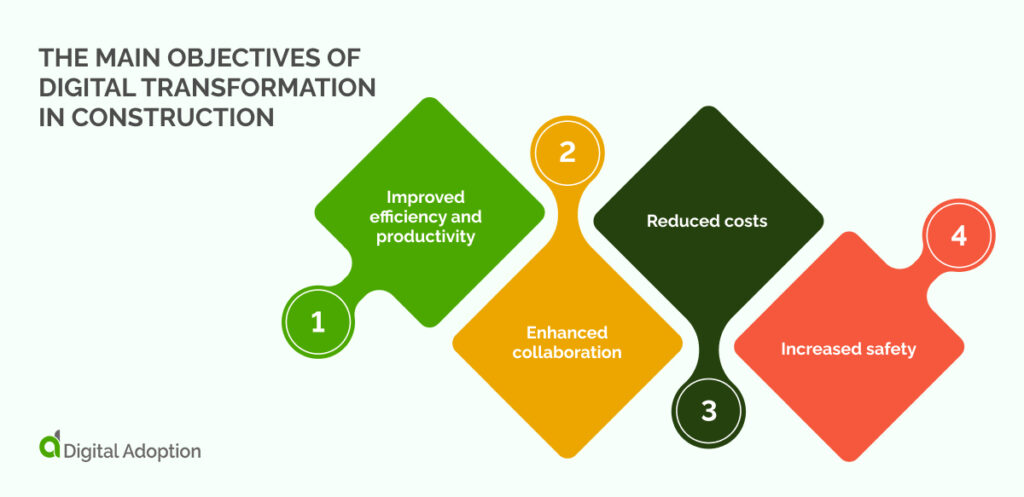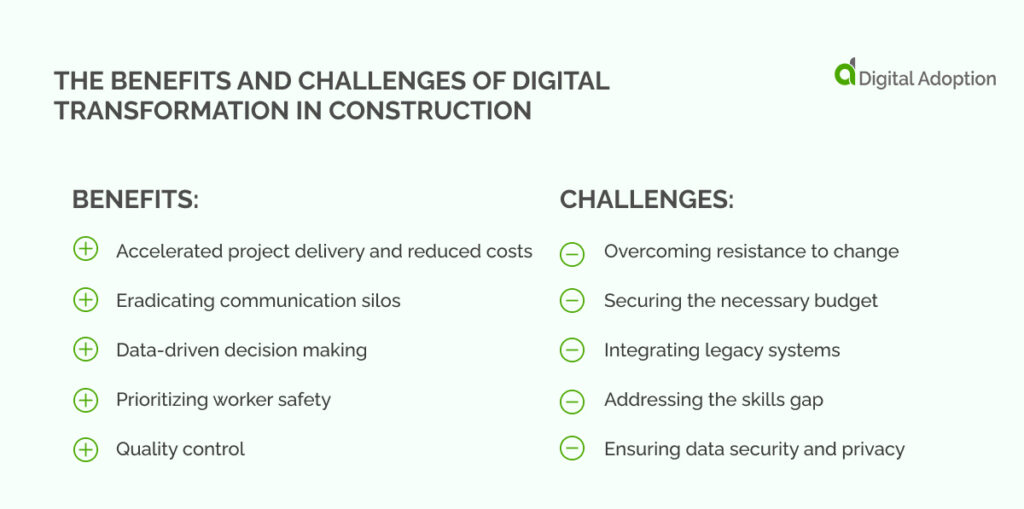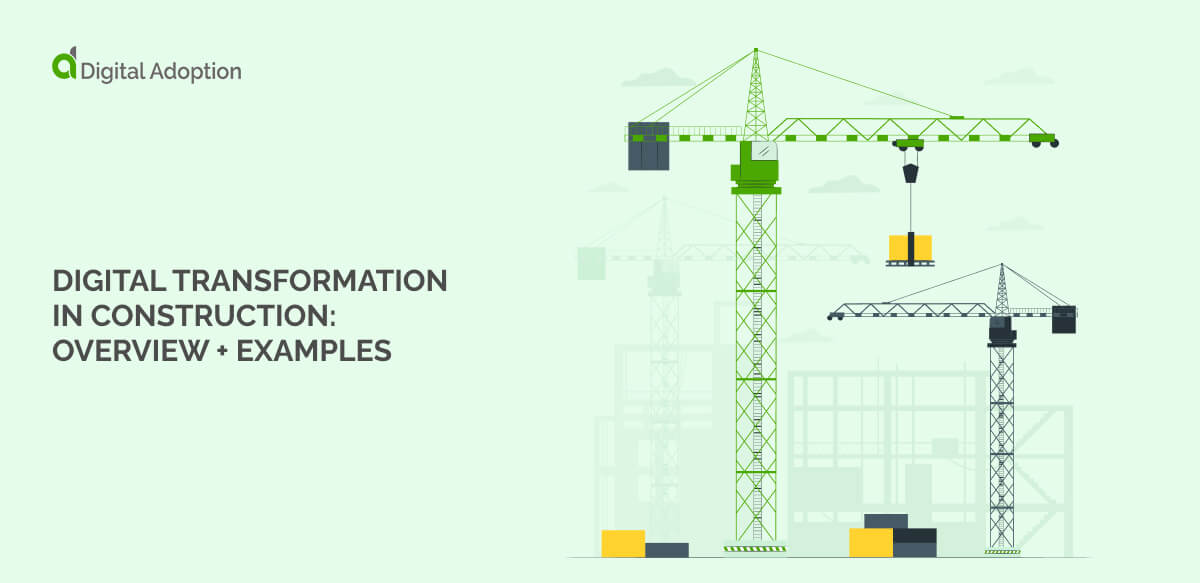The rise of new technologies forces companies to completely rethink their operations.
As new technologies emerge, established business models are being disrupted and are undergoing significant digital transformations.
This includes revamping their internal processes and embracing new technologies.
One sector poised for transformation in the coming years is the construction industry. Construction companies are under pressure to speed up operations and match the rate of cross-sector innovation.
According to McKinsey, despite late-stage investments reaching $11.5 billion between 2020 and 2022, the architecture, engineering, and construction (AEC) industry lags behind in adopting new technologies.
Growing client expectations and internal inefficiencies are motivating digital transformation in construction.
This article explores digital transformation in construction. We’ll delve into its impact, showcase success stories, and dissect the benefits and challenges that lie ahead.
- What is digital transformation in construction?
- What is the impact of digital transformation in construction?
- What are the main objectives of digital transformation in construction?
- What are some examples of digital transformation in construction?
- What are the benefits of digital transformation in construction?
- What are the challenges of digital transformation in construction?
- Striking a balance: Digital transformation in construction
What is digital transformation in construction?
Digital transformation in construction involves implementing technologies to improve the entire construction ecosystem.
Technology is being used to affect project outcomes, enhance communication, and innovate processes.
Digital transformation in construction isn’t just about adopting isolated technologies. It represents a shift in the industry’s approach to project delivery.
This transformation involves the strategic integration of technologies across the entire construction lifecycle. It includes design, planning, execution, and maintenance.
A ResearchGate study highlights the construction sector’s significant contribution to the global economy. The data shows roughly $10 trillion is spent annually on building and construction activities worldwide.
What is the impact of digital transformation in construction?
Digital transformation in construction represents a strategic shift towards a more competitive industry.
In many industries, transformations can happen within a single company. The architecture, engineering, and construction (AEC) industry is different. The AEC industry operates within a tightly interconnected ecosystem.
Major changes in digital adoption here can create a ripple effect. This impacts internal processes and external factors influencing the industry.
This transformation is particularly timely considering the immense infrastructure needs on the global stage. The McKinsey Global Institute estimates a staggering $57 trillion will be required in infrastructure spending by 2030 to keep pace with projected global GDP growth.
The traditional focus on design and planning is being enhanced through digital solutions that influence all aspects of construction. Industry cloud platforms are central, enabling real-time collaboration between teams across different geolocations.
Cloud technology is revolutionizing collaboration in the AEC industry. Architects, engineers, and contractors can now work together in real-time on a single updated digital model.
Working from this centralized environment eliminates version control issues and communication bottlenecks. This promotes transparency throughout the project lifecycle. It helps ensure everyone can access the latest information and make decisions collaboratively.
Elsewhere, Building Information Modeling (BIM) software is reimagining project planning and execution. BIM tools create data-rich 3D models of entire structures, enabling a virtual walkthrough of the project before a single brick is laid.
Clash detection software identifies potential conflicts between different building elements before construction begins. This involves assessing how plumbing intersects with electrical wiring. Or ensuring ductwork doesn’t impede access to critical maintenance points.
Identifying these clashes early helps construction firms mitigate costly rework and project delays. This saves time and resources and prevents expensive rework later in the process.
Big data is also playing a role. Construction professionals can now leverage project data from various sources, including BIM models and sensor data from construction sites, to optimize resource allocation.
Access to real-time employee activity data streamlines material deliveries and helps identify potential delays. These analytics also encourage construction companies to identify risks before they escalate into major issues, improving efficiency and cost control.
Creating a more efficient construction sector isn’t just about individual projects.
As we know, its impact extends outward. Streamlined infrastructure projects and lower construction costs for large-scale developments directly contribute to a positive economic ripple effect.
What are the main objectives of digital transformation in construction?

The construction industry has a reputation for being stuck in its old ways. Digital transformation is a golden opportunity to break free from these limitations and propel construction into the future.
However, simply throwing money at the latest tech won’t guarantee success.
Just like building a solid structure, a strategic approach is essential. Focus on investments that directly align with your project goals. These could boost efficiency or improve safety.
Think twice before getting swept up in the newest gadgets. Prioritize solutions that deliver long-term value and a clear return on investment.
The construction industry is undergoing a digital revolution. What are the key drivers of this transformation? Is it all about streamlining workflows, or are there bigger goals? Are you building safer work environments and keeping projects on budget?
Let’s explore the goals that are shaping the future of construction.
Improved efficiency and productivity
Construction projects have long been notorious for delays and cost overruns. Digital transformation smashes these roadblocks, propelling your projects forward at breakneck speed. Digital workflows handle mundane tasks, freeing your team to focus on complex problem-solving.
Cooperation across disciplines becomes effortless, with real-time data platforms keeping everyone informed. Think of digital tools as a jetpack for your construction projects. They help streamline processes and eliminate communication bottlenecks. This newfound efficiency translates to faster project completion times and significant cost savings. It helps put your construction company at the forefront of a competitive industry.
Enhanced collaboration
Construction projects are intricate ecosystems that require skilled professionals to work together. Digital tools promote collaboration and clear communication across disciplines. Cloud-based platforms are your central hub. They keep architects, engineers, and contractors on the same page. Real-time updates ensure everyone has the latest plans and specifications.
Collaboration tools tear down communication walls. They allow for instant troubleshooting and agile decision-making. Think of digital transformation as building bridges between teams. It ensures a smooth flow from design to execution. With everyone working in unison, misunderstandings become a thing of the past. This often leads to a more efficient and successful construction process.
Reduced costs
Construction projects are notorious for budget blowouts. Digital transformation helps you squeeze every penny and maximize profitability. Real-time data dashboards provide a clear view of project costs and highlight potential areas for savings. Procurement software streamlines material ordering and reduces waste. Digital timekeeping ensures accurate labor costs.
Digital tools scrutinize every expense and identify opportunities to tighten your belt. Digital transformation can be a game-changer for your construction company. Plugging budget leaks and optimizing resource allocation turns your company into a profit machine. This ensures your projects stay on budget and your bottom line thrives.
Increased safety
Digital transformation prioritizes worker well-being from the ground up. This could be a web of sensors blanketing the site. It could even collect real-time data on air quality, worker movement, and environmental conditions. Advanced data analytics identifies potential hazards before they become accidents.
Heatstroke risks trigger schedule adjustments to avoid peak heat hours. Worker location data combined with fall risk assessments lead to immediate implementation of targeted safety protocols.
This data-driven safety culture empowers everyone on site to identify and mitigate risks. Workers wear advanced monitors that track vitals and environmental conditions, preventing fatigue-related accidents.
Virtual reality training programs immerse them in realistic scenarios. This allows them to practice safety protocols in a controlled environment.
What are some examples of digital transformation in construction?
Construction companies recognize the need to innovate. They acknowledge the importance of embracing cutting-edge technologies to transform their design, construction, and project management.
Let’s delve deeper into some of the most impactful examples of DX in construction today:
Digital twins
Digital twins are virtual replicas of physical objects. Leveraging digital twins in construction creates a virtual learning environment. Construction professionals can study and learn from detailed 3D models of building projects.
The benefits go beyond learning. Digital twins can predict maintenance needs, optimize energy use, and identify safety hazards before they become real problems.
The Shard, London’s iconic skyscraper, exemplifies the power of digital twins. A virtual replica, infused with real-time sensor data, became a powerful tool for optimizing energy usage. This digital twin wasn’t just a fancy model. It analyzed everything from temperature to occupancy, pinpointing areas where energy was wasted.
This real-time data empowered architects, developers, and engineers. They could model and test different strategies in the virtual environment. This identified ways to reduce energy consumption without compromising the comfort of the building’s occupants.
The Internet of Things (IoT)
Construction sites are becoming increasingly intelligent, and a network of the Internet of Things (IoT) collects valuable data. These interconnected devices collect and transmit real-time data.
This includes everything from sensors embedded in materials to wearables on workers. This data stream empowers a new level of control.
In one of their stadium projects, Turner Construction embedded temperature and humidity sensors throughout the concrete foundation. This real-time data allowed for adjustments to the curing process, ensuring optimal strength and preventing cracking.
Research from Statista predicts significant growth in the IoT market, with a global revenue forecast of US$1.387 trillion by 2024. Through real-world data, IoT technologies inform better decisions, boost project quality, and streamline construction workflows.
Bid management software
Bid management software is a cloud-based solution that centralizes the entire bidding process. It allows contractors to manage proposals and subcontractor quotes. It also enables real-time bid tracking via an accessible UI.
Project teams can automate workflows and standardized formats to ensure fair competition. Electronic submissions make collaborating with subcontractors easier.
The software also generates valuable data for data-driven pricing strategies. This ultimately increases contractors’ chances of securing profitable projects.
For example, PlanGrid eliminates communication bottlenecks on blueprints. Project teams can now mark up plans directly on tablets, ensuring everyone has the latest version and minimizing errors.
Alternatively, Procore is a hub for budgets, schedules, and tasks. Project managers can optimize resource allocation and proactively identify delays down the line. Smoother project execution and increased profitability are just some ways bid management software is transforming construction today.
Construction project management software (CPMS)
Construction companies are undergoing a major digital transformation. Construction Project Management Software (CPMS) is a key driver of this change. CPMS acts as a central hub, consolidating all project data. This includes schedules, budgets, and resource allocation into one user-friendly platform.
Construction companies can now proactively manage projects using CPMS. This helps identify and mitigate potential delays early on. It allows project teams to adjust and redirect resources as needed. CPMS also offers a shared workspace where teams can streamline workflows and improve decision-making.
U.S. construction company DPR Construction used CPMS to move away from traditional Critical Path Method (CPM) scheduling.
For their $320 million hospital project, a detailed CPM would have included thousands of activities based on assumptions. Instead, DPR utilized CPMS to create a dynamic schedule with only 23 key milestones. This allowed for ongoing collaboration with subcontractors and adjustments as the project unfolded. It resulted in a highly efficient workflow.
Building information modeling (BIM)
BIM goes beyond traditional 3D modeling. Building Information Modeling (BIM) creates a digital twin of a building. It captures both its physical structure and its functionality. This allows architects, engineers, and contractors to work together seamlessly. They can identify and fix conflicts between building elements before construction even starts. This significantly reduces the need for expensive rework later on.
The construction of the Shanghai Tower best embodies expert digital transformation in the construction industry. Shanghai Construction used BIM to create a comprehensive digital model encompassing every aspect of the tower, from the intricate diagrid facade to the layout and integration of critical building systems.
“We knew that if we tried to work in a traditional way, using traditional tools and delivery systems, it would be extremely difficult to carry out this project successfully,” says Jianping Gu, general manager of the tower between 2006 and 2022.
This central model served as a single source of truth for all stakeholders. It included over 30 architectural, engineering, and construction firms involved in the project.
Construction CRM software
Construction CRM software is a customer relationship management (CRM) platform designed specifically for the construction industry. It centralizes lead management, proposal creation, and communication with project stakeholders.
These platforms leverage automation to streamline workflows. Automated tasks include sending quote reminders, tracking project documents, and flagging potential delays. Employees can reduce their workload and mitigate errors caused by disparate data.
Alaska Native Tribal Health Consortium (ANTHC) needed software to manage all three phases of its community construction projects. To manage complex construction projects across vast Alaskan communities, ANTHC turned to Microsoft Dynamics CRM.
ANTHC embraced Dynamics CRM to streamline its clinic construction process. Dynamics CRM became ANTHC’s command center for clinic construction. It tracked leads, managed architect and contractor proposals, and even monitored deliveries to remote sites.
This one platform kept everyone informed, from project managers to local communities. It also helped ensure a smooth building process.
The latest digital solutions are simplifying the process of estimating construction materials.
Accurate material estimation is crucial for project budgeting and cost control. MTO solutions and estimating tools leverage historical data and industry benchmarks to provide precise estimations of project materials. This reduces the risk of cost overruns and ensures efficient material procurement.
Numerous construction estimation software programs are on the market. Choosing the right one depends on each company’s specific needs. Today, a few digital solutions for material estimation are gaining traction within the construction industry.
Construction firms leverage tools like Autodesk Takeoff to streamline their estimating process. This resulted in a 20% reduction in time spent on takeoffs.
What are the benefits of digital transformation in construction?

We’ve identified the following examples to help you better understand the impact of digital transformation in higher education.
Accelerated project delivery and reduced costs
Digital tools automate repetitive tasks, streamline workflows, and boost team communication. This translates to faster project completion times, minimizing labor costs and allowing for quicker project turnaround. Additionally, digital tools can optimize material ordering, reducing waste and unnecessary expenses.
Eradicating communication silos
Cloud-based platforms act as a central hub. They ensure real-time access to project information for all stakeholders. This eliminates communication gaps and creates a collaborative environment where everyone works together. This, in turn, reduces misunderstandings and establishes faster decision-making and problem-solving.
Data-driven decision making
Digital tools provide valuable data insights throughout the entire project lifecycle. Data analysis unlocks valuable insights for construction companies. These insights empower them to identify cost-saving opportunities. These include optimizing material ordering, minimizing waste, and ensuring accurate labor cost tracking.
Prioritizing worker safety
Digital transformation extends beyond efficiency gains; it prioritizes worker well-being. A network of sensors collects real-time data on air quality, worker movement, and environmental conditions.
Advanced analytics software analyzes this data, identifying potential hazards before accidents occur. This proactive approach allows for implementing preventative measures, creating a safer work environment, and minimizing the risk of injuries.
Quality control
3D modeling software acts as a virtual blueprint, allowing clash detection during the design phase. Digital tools act as a safety net for construction projects. It recognizes potential clashes between building elements before construction even starts.
This ensures high-quality buildings are delivered on time and within budget. Early problem detection through digital tools guarantees a smoother construction process and a flawless final product.
Identifying clashes between building elements early is crucial for construction. Digital technology tackles this challenge by pinpointing potential conflicts before construction begins. This minimizes costly rework. It helps ensure high-quality buildings are delivered on time and within budget.
What are the challenges of digital transformation in construction?
Now that you understand the benefits of digital transformation in construction, we will explore the challenges of effectively implementing these new technologies in the workplace.
Overcoming resistance to change
The construction industry has a legacy of established methods and workflows. Moving to a digital-first approach in construction won’t be smooth sailing for everyone. Some stakeholders, comfortable with traditional methods, might resist change. Effective change management, clear communication, and emphasizing the benefits of digital tools are essential to overcoming this resistance.
Securing the necessary budget
Implementing digital solutions requires investment. Obtaining buy-in from leadership and securing the necessary budget can be a challenge. However, construction companies can build a strong case for digital transformation by demonstrating the potential return on investment (ROI) through cost savings, improved efficiency, and reduced rework.
Integrating legacy systems
Construction companies often rely on existing software and data systems. Integrating these legacy systems with new digital tools can be complex and time-consuming. Careful planning, data migration strategies, and partnering with experienced technology providers are essential to ensure a smooth and successful integration process.
Addressing the skills gap
Digital transformation necessitates a workforce equipped with the skills to utilize new technologies. Bridging the digital skills gap is crucial for construction firms to thrive in this new era. This may involve upskilling existing employees or recruiting new talent with digital fluency. Investing in training programs and a culture of continuous learning are key to building a digitally capable workforce.
Ensuring data security and privacy
Digital transformation hinges on data collection and analysis. However, this raises concerns about data security and privacy. Construction companies must implement robust cybersecurity measures, comply with data privacy regulations, and responsibly handle sensitive project information.
Striking a balance: Digital transformation in construction
The construction industry is ripe for digital transformation, but hurdles must be overcome. Scaling these advancements presents a unique set of challenges.
Construction projects are complex, and new technologies often require substantial upfront costs. This can lead to hesitancy, as companies are wary of adopting unproven solutions.
Unlike a factory assembly line, construction is inherently unique. It requires a nuanced approach to technology. The lack of a “one-size-fits-all” solution makes the decision-making process even more complex for construction companies.
However, the future of construction appears undeniably digital.
According to Cemex Ventures, Global investment in construction technology reached $4.5 billion in 2021, surpassing the prior record of $1.8 billion set in 2018.
Navigating digital transformation is a critical challenge for today’s construction firms. They must consider their specific needs while remaining committed to productivity and innovation.









